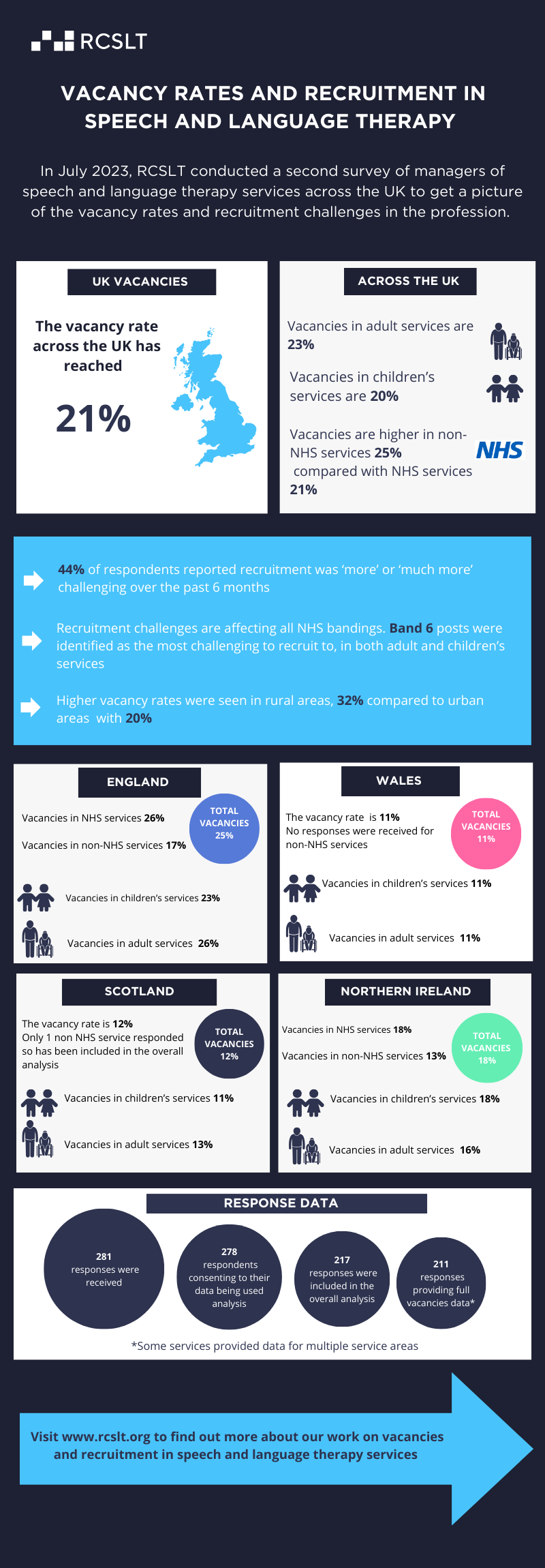25 January 2024
In July 2023 we asked managers of speech and language therapy services to tell us about vacancy rates and recruitment issues. This is the second in a series of regular surveys to assess the situation with the speech and language therapy workforce. The latest results show vacancy rates continue to be unsustainably high. The third of these surveys is now also open for managers to complete by 7 March.
The vacancy rate in adult services is 23% and that in children’s services is 20%. Regional rates are variable, with the highest apparent in the North East and Yorkshire, the Midlands and the East of England.
Vacancy rates were also higher in rural areas and in non-NHS services Indicating further challenges in recruiting speech and language therapists outside of our cities.
We know that services are working hard to innovate and make productivity gains wherever they can. However, vacancies are only part of the challenge facing many services. There remain significant barriers to making those innovation gains, that need to be urgently addressed by Government as part of the solution. Those barriers include:
- A recognition by Government and commissioners, that even where services are fully staffed, data in those services is showing that demand is far exceeding capacity. For too long a lack of system wide workforce planning for speech, language, communication and swallowing needs has meant that this excess demand has gone unaddressed. One fully staffed service in the Midlands has told us that demand exceeds capacity 4 times over.
- The need for joint commissioning (in England) of all children’s services across health and education – this one step would transform and streamline the provision of children’s speech and language therapy services. Piecemeal commissioning of children’s services eats up huge amounts of managers’ time. We are calling on all Integrated care boards (ICBs) to work with local authorities and settings to achieve this, and for the Government to mandate this as a priority.
- Commissioners need to move away from specifications that only measure activity and waiting times, and towards a system-wide approach where success is based on delivering improved outcomes.
- The long term workforce plan in England envisages a large growth in the SLT workforce – we are pleased that more SLT degree apprenticeships are starting up and more universities are offering courses, but stretched services need much more practical support for arranging placements and transparency in receiving the placement tariff (in England), to help with this large increase in student numbers.
- In Wales, Scotland and Northern Ireland there are significant supply issues with little or no growth in the number of SLT students and no progress towards the degree apprenticeship being made available in these nations.
- A lack of senior SLT leaders in the NHS – these posts have been steadily removed over the last 10 years and we are calling for their reinstatement to secure appropriate clinical and professional leadership. These positions would also provide a focus for innovation and change as well as opportunities for progression in the profession to improve retention of expertise and specialism.

Next steps
Read our recruitment tips suggested by members who responded to the survey, to help you with your vacancy challenges.
Next survey
So that we can continue to monitor the situation closely please complete our latest survey by 7 March 2024. The survey is open to anyone who manages an SLT service, whether it is based in the NHS or not, as well as those managing SLTs across different settings.
